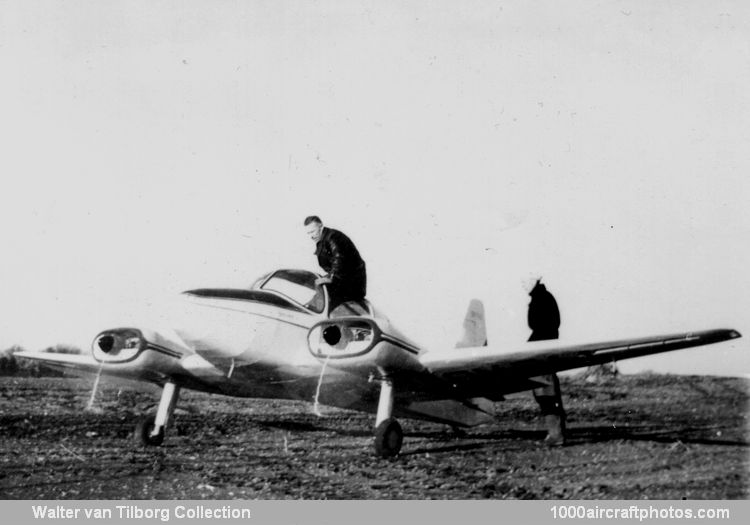The H.T.1 was of all-wood construction and would be fabric covered, however, during construction the covering was changed from fabric to glued-on aluminum sheets, at that time a rather advanced method, to provide additional strength and durability as well as smoother roundings. It was powered by two converted Volkwagen car engines.
Due to the change in construction, the DCA did not issue a CofA nor a registration, but by dispensation the H.T.1 was first flown on April 24, 1964, with Harald Thyregod at the controls. Subsequently the aircraft was stored. Finally, on April 1, 1969, the DCA granted a restricted CofA to the type that was registered to Arne Hollænder as the Hollænder H.T.1, allotted registration was OY-FAI. This allowed the H.T.1 to be flown exclusively by Hollaender and mostly in the region of his farm.
The aircraft designation is rather complicated, usually it is referred to as Hollænder H.T.1 (one of the builders and the initials of the designer), but sometimes it is referred to as Thyregod H.T.1 (name and initials of the designer), as Hollænder-Thyregod H.T.1, or as Hollsmidt 222 (contraction of the names of the builders).
In 1978 the sole example of the H.T.1. was donated to the Dansk Veteranflysamling (Danish Vintage Aircraft Collection) at Stauning and was occasionally flown by instructor Bent Larsen. Due to the glued-on covering, the condition of the woodwork could not be examined and after 300 hours total time the OY-FAI was deregistered on December 23, 1987. The aircraft is still on display at Stauning."
Type: Two-seat amateur-built light aircraft.
Wings: Cantilever low-wing monoplane. Wing section NACA 23012. Wooden structure, with glued aluminum skin. Ailerons and split flaps, of similar construction, on trailing edge. Trim-tab in aileron. Fixed slot 2 ft 11.5 in (0.90 m) from each wing tip.
Fuselage: Conventional structure, of wooden frames and longerons with glued aluminum skin.
Tail unit: Cantilever wooden structure with glued aluminum skin. Trim-tab in elevator.
Landing gear: Non-retractable tail wheel type, with friction-damped steel spring shock absorption on main units. Main wheels and tires size 4.00-4, pressure 21 lb/sq.in (1·5 kg/sq.cm). Mechanical drum brakes.
Power plant: Two 30 hp Volkswagen 1200 cc engines, each driving a two-blade fixed-pitch wooden propeller. Fuel in two tanks, one in each wing with total capacity of 10.57 gal (40 l). Refueling point above each wing. Oil capacity (total) 1.32 gal (5 l).
Accommodation: Side-by-side seating for pilot and one passenger in fully-enclosed cabin. One forward-opening door on each side. Cabin heated and ventilated. Space for 44 lb (20 kg) of baggage.
Span: 29 ft 4.25 in (8.95 m)
Length: 17 ft 2.75 in (5.25 m)
Height: 5 ft 5 in (1.65 m)
Wing area: 107.6 sq.ft (10.00 sq.m)
Wing aspect ratio: 8
Wing chord, at root: 6 ft 3.5 in (1.92 m)
Wing chord, at tip: 1 ft 11.75 in (0.60 m)
Ailerons area (total) : 16.1 sq.ft (1.50 sq.m)
Trailing edge flaps area (total): 16.1 sq.ft (1.50 sq.m)
Fin area: 3.23 sq.ft (0.30 sq.m)
Rudder area, incl. tab: 5.92 sq.ft (0.55 sq.m)
Tail plane span: 8 ft 2.5 in (2.50 m)
Tail plane area, incl. tab: 10.8 sq.ft (1.00 sq.m)
Elevators area, incl. tabs: 8.07 sq.ft (0.75 sq.m)
Wheel track: 9 ft 2.25 in (2.80 m)
Propeller diameter: 4 ft 5 in (1.35 m)
Propeller ground clearance: 8.75 in (0.22 m)
Cockpit width: 3 ft 5.25 in (1.05 m)
Cockpit height: 2 ft 9.5 in (0.85 m)
Empty weight: 672 lb (305 kg)
Max take off weight: 1,102 lb (500 kg)
Wing loading: 10.2 lb/sq.ft (50 kg/sq.m)
Power loading: 18.3 lb/hp (8.3 kg/hp)
Max level speed: 106 mph (170 kmh)
Max dive speed: 186 mph (300 kmh)
Cruise speed: 99 mph (160 kmh)
Econ cruise speed: 87 mph (140 kmh)
Max cruise speed: 99 mph (160 kmh)
Stall speed: 41 mph (65 kmh)
Climb: 689 ft (210 m)/min
Take off run: 410 ft (125 m)
Take off to 50 ft (15 m): 820 ft (250 m)
Landing from 50 ft (15 m): 820 ft (250 m)
Landing run: 328 ft (100 m)
Range: 248 mls (400 km)
